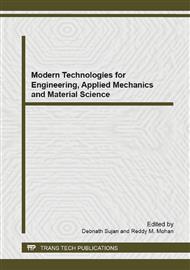[1]
ANSI/ISA-95. 00. 01-2000. (2000). Enterprise-Control System Integration Part 1: Models and Terminology.
Google Scholar
[2]
ANSI/ISA-95. 00. 02-2001. (2001). Enterprise-Control System Integration Part 2: Object Model Attributes.
Google Scholar
[3]
ANSI/ISA-95. 00. 03–2005. (2005). Enterprise-Control System Integration Part 3: Activity Models of Manufacturing.
Google Scholar
[4]
Cao, W. -q., Jing, S. -h., & Wang, X. -h. (2008). Research on Manufacturing Execution System for Cement Industry. Industrial Electronics and Applications, 2008. ICIEA 2008. 3rd IEEE Conference on, (pp.1614-1618).
DOI: 10.1109/iciea.2008.4582792
Google Scholar
[5]
Deuel, A. (1994). The benefits of a manufacturing execution system for plantwide automation. ISA Transactions, 113-124.
DOI: 10.1016/0019-0578(94)90042-6
Google Scholar
[6]
Dufort, Y. (2006). ISA-95-Based Operations and KPI Metrics Assessment and Analysis. MESA White Paper 24.
Google Scholar
[7]
Fuchs, F., & Thiel, K. (2009). Manufacturing Execution Systems: Optimal Design, Planning, and Deployment. New York: McGraw-Hill.
Google Scholar
[8]
Fukuda, Y., & Patzke, R. (2010). Standardization of Key Performance Indecator for Manufacturing Execution System. SICE Annual Conference 2010, (pp.263-265).
Google Scholar
[9]
Grässle, P., Baumann, H., & Baumann, P. (2004). UML 2. 0 in Action A Project-Based Tutorial. Birmingham: Packt Publishing Ltd.
Google Scholar
[10]
Hadjimichael, B. (2004). Manufacturing Execution Systems Integration and Intelligence. Master Thesis, McGill University, Department of Electrical and Computer Engineering, Montreal.
Google Scholar
[11]
Mcclellan, M. (2004). The Collaborative Effect. Intelligent Enterprises, 7(16), 35.
Google Scholar
[12]
Presley, A., & Liles, D. (1995). The Use Of IDEF0 For The Design and Specification of Methodologies. 4th Industrial Engineering Research Conference, (pp.442-448). Nashville.
Google Scholar
[13]
Pressman, R. (2010). Software Engineering: A Practitioner's Approach (7th ed. ). New York: McGraw-Hill.
Google Scholar
[14]
Qiu, R., & Mengchu, Z. (2004). Mighty MESs: state-of-the-art and future manufacturing execution systems. Robotics & Automation Magazine, IEEE, 11, 19-25.
DOI: 10.1109/mra.2004.1275947
Google Scholar
[15]
Scholten, B., & Schneider, M. (2010). ISA-95 As-Is / To-Be Study. MESA White Paper 23.
Google Scholar
[16]
Waldron, T. A. (2011). Strategic Development of a Manufacturing ExecutionSystem (MES) for Cold Chain Management Using Information Product Mapping. Master Thesis, Massachusetts Institute of Technology, Department of Chemical Engineering.
Google Scholar
[17]
Whitten, J., & Bentley, L. (2007). Systems Analysis and Design Methods (7th ed. ). New York: McGraw-HIll.
Google Scholar


